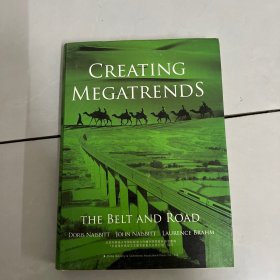
Creating Megatrends:The Belt and Road
正版现货当天发货
¥ 54 7.9折 ¥ 68 九五品
库存3件
重庆万州
认证卖家担保交易快速发货售后保障
作者Doris、Naisbitt、John、Naisbitt、Laurence 著
出版社中华工商联合出版社
出版时间2017-09
版次1
装帧精装
货号E2
上书时间2024-04-05
- 最新上架
商品详情
- 品相描述:九五品
图书标准信息
- 作者 Doris、Naisbitt、John、Naisbitt、Laurence 著
- 出版社 中华工商联合出版社
- 出版时间 2017-09
- 版次 1
- ISBN 9787515820675
- 定价 68.00元
- 装帧 精装
- 开本 16开
- 纸张 胶版纸
- 页数 216页
- 字数 200千字
- 正文语种 英语
- 【内容简介】
-
China's Belt and Road Initiative is a project of unprecedented scale.
Neverthelcss, know[edge about the potitico[, ocoriomir nnd rcjltural goals and opportunities are Lagging behind.
Creating Megatrends presents the narrative of the chances and risks in China's Belt and Road Initiative. In the past, Large shifts in economic. technological and social developments have resulted from trends and ideas beginning bottom up in cities and Loca[ communities. finally forming a Megatrend. No one was in charge. China's Belt and Road Initiative goes the opposite way.
China's Initiative offers the strategic framework of reinventing globalization, orchestrated, but Leaving space to maneuver for all p.irticipants. The underlying principal is sharing: China's own exponcnce, its economic Succoss story of developing through investments in road.rait and port networks,and smart ec o[ogical citics. It is working with nations, involving advanced technologies, management experience. It is stabililing Volatile reqions and COuntrics by helping thcm to find their own approach to progress and development.
Belt and Road Initiative is creating the infrastructure and connectivity needed to Link communities and create and Leverage on economic opportunities for state and private investment, entrepreneurs and workmen. At the same time, involving smart infrastructure, clean energy and ecological cities, the Initiative calls for protection of environment and heritage as part of a cultural exchange.
These high set goals cannot be reach without creating a new and solid foundation aside of the o[d Bretton Woods System. Belt and Road Initiative is developing a new model of global governance, a new financiaL architecture, new financial institutions and multilateral development banks.
More than 60 percent of the world's population in more than a hundred nations are involved. Crpating Megatrends highlights the opportunities, challenges and risks th:s grand and experimontal project is facing. - 【作者简介】
-
Doris Naisbitt, an observer of global social, economic and political trends.Director of the Naisbitt China Institute. co-author of Global Game Change : Howthe Globat Southern aett Witt Reshape Our World IJanuary zoisL China'sMegatrends: Eight Pillars of a New Society, The China Model and Innovation in China.In addition to her research on future global developments Doris Naisbitt isdedicated to foster personal growth. Xinhua. the official press agency of Chinacalled her the 'global philosopher for China's youth". Her personaL experiencethat one can start a successful career Later in Life has inspired audiences and encouraged people to reinvent their own Lives.
How to make the most of your talents was the red Line of Ooris Naisbitt's biweekly column in China Youth Daily, China's second Largest newspaper. Her columns were collectively published in the book: How to Get Where You Want to Go. To bridge cultural differences between China and the US and to find and build on common grounds is the story Line her book Mai-Lin My China.
Doris Naisbitt is guest professor at Beijing Foreign Studies University, she holds protessorships at prestfgious Nankai University and Jilin University, and at Yunnan University and Skolkovo Open University Moscow as well as a honorary Doctor of South Korea's Pukyong National University.
John Naisbitt, author of the # 1 New York Times bestseller Megatrends, has been in the Limelight of the publishing worLd ever since the book was published 1982. It remained on the New York Times bestsetler for almost two years, mostLy as number one. Megatrends was one of publishing's greatest success stories, selling more than 1t million copies in 57 countries. The Watt Street Journal called John Naisbitt's work 'triumphantly usefuL...taking bearings in all directions and giving us the courage to do the same."
t-kgatrends was followed by internationaL bestsellers: Re-inventing the Corporation in 1 9as, Megatrands 2000 in 1990. Megatrends for Women 1 991 . Global Paradox 1 992, Megatrends Asia 1995. High Tech High Touch, 1 999 and MindSet! in 2006.
John Naisbitt holds 21 honorary doctor degrees and protessorships from American, Chinese and Russian Universities and is honorary Doctor of South Korea's Pukyong National University.
In his early career John Naisbitt was an executive at Kadak and IBM. At age 34 John Naisbitt was appointed assistant secretary of education to President John Kennedy. After the president's assassination he was appointed special assistant to President Lyndon _lohnson. Urged by the social and racial turbulences in America's cities John Naisbitt began to analyse social economic and political developments in the US. which ted to publishing Megatrends in 1982.
Doris and John Naisbitt
After working together as publisher and author from 1995 to 2000, John Naisbitt and Doris Naisbitt. his former German Language publisher, married in 2000 and began their collaboration as co-authors. They speak to audiences in Asia, Latin America, Africa, Europe and the US, and have appeared on many television programs, written for first-tier publications, and addressed numerous government and policymaking institutions.
Laurence J. Brahm, is an international crisis mediation lawyer and developmental economist. He is founder of the Himalayan Consensus, a regionaL multi-stakeholder multi-lateral process dedicated to the prevention of conftict over water resources due to climate disruption.
Between 2013-2015. as Senior Advisor to China's Ministry of Environmental Protection he was Lead drafter of 'EcologicaL Civilization-. China's 'green print' for renewable energy and water conservation. During this period he also served as advisor to Bhutan's National Environmental Commission. In 2015 Iceland's President Olafur Ragnar Grimsson invited him to serve on the HimaLaya - Third
Pole Circle, a panel forming poLicy responses to glacial melt caused by cLimate change. In 2012 as NGO spokesperson to the United Nations Earth Summit 2012
IRio+20J, he was seLected by ScenaRio as one of the "100 Opinion Leaders Advising R1o+20". In 2010 he received the UNDP Award for Bio-Diversity and
CuLturaL Protection in China presented by Jane Goodall. In 2008 China Central Television selected him as the only foreigner among ten individuals recognized tor contributing to China's three decades of econamic reforms and opening.
As explorer and documentary film director, between 2002-2009 he Led a series ofthree expeditions across the ainghai-Tibet pLateau searching for the mythical kingdom of Shangri-la, for which he was elected Fellow International of the New York ExpLorer's Club in 2015. In 2016, dubbed "The Millennium Expedi-tions" by Three Shadows Photography Art Center, the 'Searching for Shangri-la' documentary series received the National Geographic Air and Water Conserva-tion Award for raising awareness of the glabal climate crisis.In 2017. the School of International Journalism and Communicatian, Beijing Foreign Studies University, appointed him "People-to-People Ambassador for Cultural Communications on the Belt and Road Initiative". - 【目录】
-
Introduction to a high potential project l
Chapter One Introduction Into China's Belt and Road Initiative l
Thinking local acting global
Increase the quality of exports
Proceeding on ever higher levels
Chapter Two B&R in the global context
The political aspect of B&R
The econonuc reach of B&R
At the crossroadl
China's changing image
Keeping the momentum of growth
Infrastructure networks to assure market accessibility
Strategically shifting growth
China's B&R risk considerations
Security through economic progress and hope
Chapter Three The Creation of a Megatrend
Regional and intemational cooperation instead of confrontation
The Belt and Road: Visions and Question
Question 1: What does the Belt and Road stand for?
Question 2: What are the historical roots of the Belt and Road?
Question 3: What are the 2lst century routes of B&R?l
The Belt and Road Initiative: Six Economic Corridors
Spanning Asia, Europe and Africa l
The six key routes:
The six strategic international economic co-operation corridors:
The six international economic co-operation corridors
1. The new Eurasia Land Bridge
2. The China-Mongolia-Russia Economic Corridor
3. China-Central Asia- West Asia Economic Corridor
4. China-Indochina Peninsula Economic Corridor
5. China-Pakistan Economic Corridor
6. Bangladesh-China-India-Myanmar Economic Corridor
China's role as a marine superpower
……
Chapter Four Question 5: What are the continents involved?
Chapter Five Question 6: Which are the countries joining? l
Chapter Six Question 7: How will the Belt and Road be funded?
Chapter Eight Question 9: What are B&R sector strategies?
Chapter Nine Question 10: What are China's six domestic B&R strategies?
Chapter Ten Question 11: Will the yuan become a reserve currency?
Chapter Eleven B&R's Environmental Policy
Chapter Twelve Green Finance in a Green Silk Road
Chapter Thirteen Re-inventing Globalization
Silk Road Timeline
ACKNOWLEDGEMENTS
点击展开
点击收起
— 没有更多了 —














以下为对购买帮助不大的评价